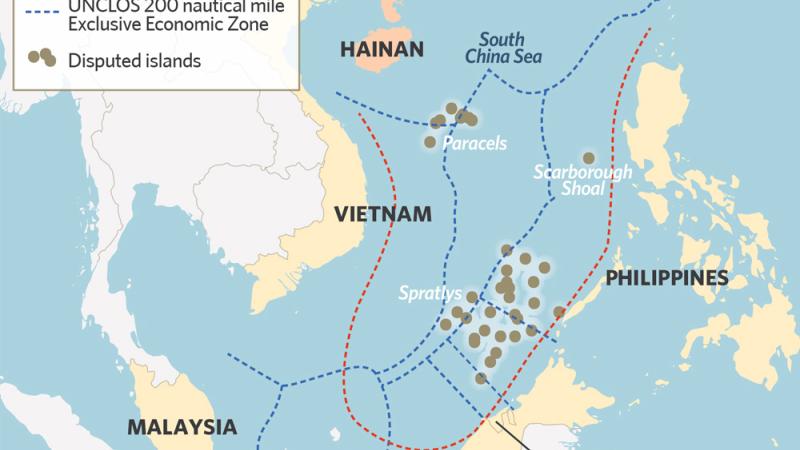Tensions in the South China Sea continue to shape the balance of power in the Indo-Pacific, making it one of the most strategically significant and contested maritime regions in the world. Claimed by multiple nations — including China, the Philippines, Vietnam, Malaysia, Brunei, and Taiwan — the area holds immense geopolitical, economic, and security importance. Beyond being a vital commercial route through which goods worth over $3 trillion pass annually, the sea is believed to contain rich fishing grounds and vast untapped energy reserves.
China’s expansive claims, marked by its “Nine-Dash Line,” have heightened regional disputes. The construction of artificial islands, deployment of military assets, and enforcement of maritime boundaries have drawn criticism and increased tensions with neighboring states and external powers. The United States, emphasizing freedom of navigation, regularly conducts naval patrols to counter perceived Chinese overreach. Meanwhile, ASEAN nations attempt to balance between protecting sovereignty and maintaining economic ties with Beijing.
Diplomatic initiatives, such as ongoing negotiations over a Code of Conduct between China and ASEAN, aim to ease tensions, but progress has been slow. The dispute remains deeply intertwined with global trade and security interests, especially amid the growing U.S.-China rivalry.
Table of Contents
ToggleGeopolitical Stakes
The South China Sea’s geopolitical weight lies in its dual nature — as a rich resource hub and as one of the busiest maritime corridors in the world. Control over this region means access to critical sea lanes, energy reserves, and influence over regional trade. Consequently, no claimant nation is willing to compromise.
The United States’ Freedom of Navigation Operations (FONOPs) challenge what Washington calls China’s “excessive maritime claims.” The U.S. maintains that it takes no position on territorial sovereignty but insists on open sea lanes under international law. International legal frameworks such as the United Nations Convention on the Law of the Sea (UNCLOS) and the 2016 Permanent Court of Arbitration ruling — which invalidated China’s Nine-Dash Line — remain central reference points, though Beijing rejects them.
These overlapping claims and competing legal narratives make the South China Sea an enduring flashpoint of international maritime law, trade, and security.
Key Stakeholders
China seeks to assert dominance through militarization and administrative control, expanding its presence through artificial islands and forward-deployed defense systems. The United States, while not a direct claimant, uses FONOPs and defense partnerships to counterbalance China’s rise and reassure regional allies.
Vietnam remains one of the most vocal challengers to Beijing’s claims, enhancing defense cooperation with Washington. The Philippines oscillates between engagement with China and reaffirmation of its sovereign rights under the 2016 tribunal ruling. Malaysia and Brunei, while maintaining claims, prefer quiet diplomacy and economic pragmatism to open confrontation.
This intricate balance of deterrence, diplomacy, and dependence reflects a multipolar competition in which regional states must constantly calibrate between security and economic interests.
Security Implications
China’s growing assertiveness has far-reaching security implications. Militarization of disputed areas threatens the sovereignty of Southeast Asian states and undermines ASEAN’s efforts to establish a collective regional order. Repeated maritime standoffs heighten the risk of miscalculation or accidental escalation.
The presence of both U.S. and Chinese naval forces in the same contested waters further increases the risk of confrontation, with even minor incidents potentially triggering broader crises. Beyond regional security, disruptions in the South China Sea could severely impact global trade and energy supply chains.
As a result, the South China Sea has evolved into more than a regional dispute — it has become a key testing ground for the future of maritime governance, power projection, and great-power competition in the 21st century.
Conclusion
The South China Sea remains a barometer of Indo-Pacific stability, reflecting the shifting dynamics of global power and maritime law. As ASEAN continues its efforts toward a regional Code of Conduct and external actors pursue strategic influence, the region’s future will depend on whether cooperation can outweigh confrontation.
The dispute’s resolution — or escalation — will define not only the trajectory of Southeast Asian security, but also the broader balance of power between China and the United States in the decades ahead.

Misbah Jamal
Misbah Jamal is a student of International Relations at the International Islamic University, Islamabad.













